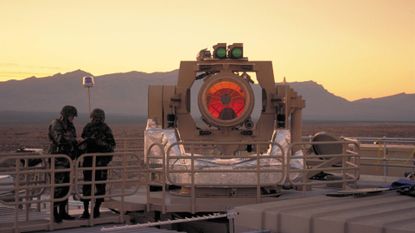JUSTIN KLAWANS

As warfare becomes continually dictated by emerging technologies, the United States military has increasingly been developing new tools to use on the battlefield. One such category is directed-energy weaponry, often described as the beginning of war's next generation.
According to various reports throughout 2023, the Pentagon is working on directed-energy weapons as one of its top priorities. While reports indicate that the military is facing hitches in development, billions of dollars are still being poured into directed-energy technology. What do these weapons do, and why is the Pentagon working so diligently to develop them?
What are directed-energy weapons?
These are electromagnetic weapons "capable of converting chemical or electrical energy to radiated energy and focusing it on a target," according to the U.S. Office of Naval Research (ONR). These weapons can cause physical damage that "degrades, neutralizes, defeats or destroys an adversarial capability," the ONR reported.
Directed-energy devices include weapons that can fire laser beams, microwaves or other types of light particles. Unlike standard weapons, directed-energy technology doesn't use traditional projectiles, but rather energy itself. Experts say this can provide opportunities on the battlefield that were previously unattainable.
While a standard weapon is limited by the number of rounds it can fire, a directed-energy weapon "gives you essentially an infinite magazine of interception opportunities," Bryan Clark, a senior fellow at the Hudson Institute, told CNBC. This is because "the laser — as long as you've got electricity — will continue to recharge, [and] continue to shoot down incoming weapons."
What is the Pentagon's plan for these weapons?
The U.S. military is looking into directed-energy weaponry as the next big advancement on the battlefield. Their development has been turbo-charged in recent years, as the Department of Defense has called directed-energy weapons "a technology critical to enabling the 2018 National Defense Strategy," according to a report released this year by the U.S. Government Accountability Office (GAO).
American forces have been testing directed-energy weapons since at least 2014, the GAO reported, and the Pentagon is "spending about $1 billion annually for the last 3 years on research and development" of these devices. However, the United States' history with directed-energy weapons goes back even further, the GAO noted, as research into battlefield applications "has been ongoing for decades ... and is currently experiencing a surge."
This uptick in directed-energy development "stems in part from advances in technology and a desire to maintain competitiveness on the battlefield." The GAO pointed out that the average military four-wheeled ATV "can now hold a high energy laser powerful enough to damage drones," something that vehicles of the past were unable to do.
And while this development remains a tightly guarded military secret, there have been some indications that directed-energy weapons are already being deployed in certain capacities. During a recent press conference, Pentagon press secretary Pat Ryder was asked if directed-energy weapons were being used to defend U.S. bases in the Middle East.
"I don't want to go into the specific capabilities that we're using to protect our forces, other than to say we have a wide variety which does include directed energy capabilities," Ryder replied. When asked for clarification, Ryder said there was "a wide variety in our inventory of the U.S. military that includes directed energy weapons."
What are the challenges with these weapons?
Since they don't use standard ammunition, directed-energy weapons "have a shorter range than more conventional weapons systems," Business Insider reported. In addition, their laser-tracking technology can often be "negatively impacted by weather conditions such as fog or storms," the outlet added.
There are also challenges surrounding the heavy financial burden that these weapons could continue to exact. Defense officials are questioning how to "affordably manufacture the high-tech capability and sustain it on the battlefield," according to military trade website Defense News. Part of the concern is that teaching soldiers how to properly use directed-energy weapons will likely be a difficult task.
When it came to conventional weapons, the Pentagon "knew what those capabilities were and trained the soldiers how to use it. We had a plan doctrinally," Lt. Gen. Rob Rasch told Defense News. "Directed-energy is an area that we didn’t know as much, not just from how to make them but how we’re going to employ them," Rasch said.
So while the military knows how to develop directed-energy weapons, what they're less certain of "is how to fight [with] them," Rasch added.
No comments:
Post a Comment